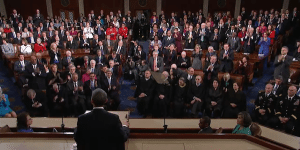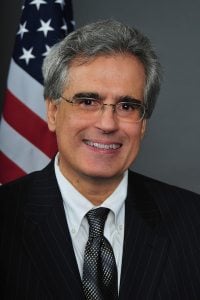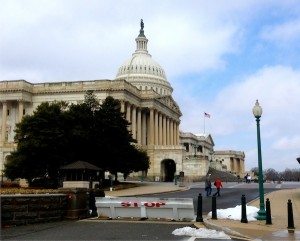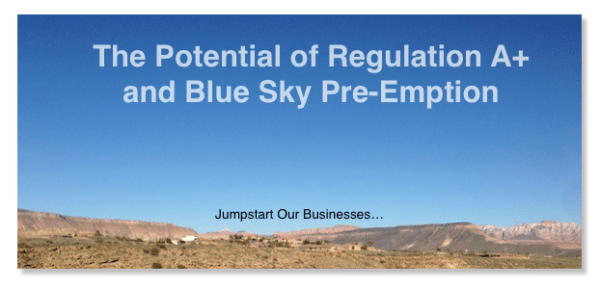Since the 1930’s Regulation A has been unremarkable as a little known and little used “exemption” from the full SEC registration process – intended to allow smaller companies to access public markets through a streamlined SEC registration process – with “reviewed” financial statements and no ongoing reporting requirements. Until recently the amount that could be raised under Regulation A was limited to $5 million, a benchmark not revisited by Congress for more than 30 years.
 The problem? – the cost-benefit calculus. Navigating the SEC review process was necessary – but not sufficient – to complete a Regulation A offering. A small company seeking to utilize Regulation A was met with a dizzying array of state “blue sky” regulations, each with its own filing and review process. And for companies with the resolve and fortitude to embark upon the Regulation A path – there were some absolute showstoppers. For example, a life sciences company with no hope of either revenues or profits in the near term – situated in the wrong state – would find the Regulation A door shut tight.
The problem? – the cost-benefit calculus. Navigating the SEC review process was necessary – but not sufficient – to complete a Regulation A offering. A small company seeking to utilize Regulation A was met with a dizzying array of state “blue sky” regulations, each with its own filing and review process. And for companies with the resolve and fortitude to embark upon the Regulation A path – there were some absolute showstoppers. For example, a life sciences company with no hope of either revenues or profits in the near term – situated in the wrong state – would find the Regulation A door shut tight.
 Then came Title IV of the JOBS Act of 2012, entitled “Small Company Capital Formation.” Congress recognized both the importance of an easier (as in less costly) path for small business to access public markets and maintain public company status – especially one that did not require a company to comply with cumbersome, often insurmountable state-level merit review. So Congress created a new and improved Regulation A, to supplement the dormant exemption. The price of admission: audited financial statements, both at the time of registration and annually thereafter; a lighter ongoing reporting regimen –– and the brass ring – exemption from blue sky review for offerings to “qualified purchasers -” the fine details being left to rulemaking at the SEC.
Then came Title IV of the JOBS Act of 2012, entitled “Small Company Capital Formation.” Congress recognized both the importance of an easier (as in less costly) path for small business to access public markets and maintain public company status – especially one that did not require a company to comply with cumbersome, often insurmountable state-level merit review. So Congress created a new and improved Regulation A, to supplement the dormant exemption. The price of admission: audited financial statements, both at the time of registration and annually thereafter; a lighter ongoing reporting regimen –– and the brass ring – exemption from blue sky review for offerings to “qualified purchasers -” the fine details being left to rulemaking at the SEC.
Despite this new and promising pathway to the public markets for smaller issuers, many prognosticators were still not very sanguine about the prospects for Title IV’s implementation. Unlike Title I of the JOBS Act, which was self-implementing – and Titles II and III, each with its own statutory deadline for SEC rulemaking – Congress provided no timetable for the rule-dependent exemption. Some pronounced it dead on arrival – with implementation dependent upon SEC rulemaking and sitting in line behind a five year+ backlog of SEC Dodd-Frank rulemaking.
What a Difference a New SEC Chair Makes
 Renewed hope for Regulation A came unexpectedly following a changing of the guard at the SEC Chair level – from Mary Jo Shapiro to Mary Jo White. On December 18, 2013, the Commission approved the issuance of proposed rules intended to implement what was informally christened as “Regulation A+.” Perhaps more surprisingly than the issuance of the proposed rules itself was the SEC’s pronouncement that all investors would be deemed “qualified investors” for purposes of the new and improved Regulation A+.
Renewed hope for Regulation A came unexpectedly following a changing of the guard at the SEC Chair level – from Mary Jo Shapiro to Mary Jo White. On December 18, 2013, the Commission approved the issuance of proposed rules intended to implement what was informally christened as “Regulation A+.” Perhaps more surprisingly than the issuance of the proposed rules itself was the SEC’s pronouncement that all investors would be deemed “qualified investors” for purposes of the new and improved Regulation A+.
The proposed rules were greeted by many on Wall Street and in the small business community as a potential game changer for small business and the tepid small cap IPO market. But others, most notably the North American Securities Administrators Association (NASAA) cried foul – claiming that the SEC had not played the game by the rules set by Congress. Instead, they argued that the SEC exceeded its authority by broadly defining “qualified purchasers” to include all purchasers. And they continue to cry loudly as the SEC mulls over the final rules.
 It started with a visit to the SEC by William Galvin, Massachusetts Secretary of State and chief state securities regulator – eight days before the proposed rules were even issued! And the disdain of Massachusetts’s regulators was punctuated by a terse comment letter submitted by Secretary Galvin on the very same day the proposed rules were issued. This was to be the beginning of a war centered around blue sky pre-emption, at least as far as Regulation A and unaccredited investors were to be concerned. By time the official public comment had closed on the proposed Regulation A rules on March 24, state administrators had submitted a multitude of comment letters railing against the SEC’s broad pre-emption of their authority – and the jeopardy it created for the investor citizenry of their respective states. However, by all accounts it appears that NASAA has yet to get its way with the SEC – and in this writer’s opinion it is highly doubtful that it will.
It started with a visit to the SEC by William Galvin, Massachusetts Secretary of State and chief state securities regulator – eight days before the proposed rules were even issued! And the disdain of Massachusetts’s regulators was punctuated by a terse comment letter submitted by Secretary Galvin on the very same day the proposed rules were issued. This was to be the beginning of a war centered around blue sky pre-emption, at least as far as Regulation A and unaccredited investors were to be concerned. By time the official public comment had closed on the proposed Regulation A rules on March 24, state administrators had submitted a multitude of comment letters railing against the SEC’s broad pre-emption of their authority – and the jeopardy it created for the investor citizenry of their respective states. However, by all accounts it appears that NASAA has yet to get its way with the SEC – and in this writer’s opinion it is highly doubtful that it will.
Blue Sky Ahead for Regulation A+?
 Many industry supporters were alarmed at the news which surfaced three days after the Regulation A comment period closed, as reported in an article which appeared on Reuters on March 27. The headline: “State Regulators Hire Outside Lawyer for Turf War With U.S. SEC.” According to the article, NASAA had retained Tom Sporkin, a seasoned securities litigator who cut his teeth at the SEC’s Enforcement Division for nearly 20 years, now with the firm of BuckleySandler LLP in Washington. Andrea Seidt, President of NASAA and chief securities officer for the state of Ohio, said of Sporkin’s role: “We certainly value his input. He is helping us solidify our thinking.” A good idea indeed, before NASAA considers upping the ante in its confrontation with the SEC.
Many industry supporters were alarmed at the news which surfaced three days after the Regulation A comment period closed, as reported in an article which appeared on Reuters on March 27. The headline: “State Regulators Hire Outside Lawyer for Turf War With U.S. SEC.” According to the article, NASAA had retained Tom Sporkin, a seasoned securities litigator who cut his teeth at the SEC’s Enforcement Division for nearly 20 years, now with the firm of BuckleySandler LLP in Washington. Andrea Seidt, President of NASAA and chief securities officer for the state of Ohio, said of Sporkin’s role: “We certainly value his input. He is helping us solidify our thinking.” A good idea indeed, before NASAA considers upping the ante in its confrontation with the SEC.
 As a securities lawyer practicing for more than 35 years I was initially surprised by the SEC’s bold move to pre-empt blue sky review for offerings involving unaccredited investors. However, a closer look has led me to conclude that the SEC has constructed an elegant (and lawful) paradigm for bringing unaccredited investors into the Regulation A+ “qualified purchaser” circle. In addition to incorporating investor protection measures dictated in the federal legislation itself (audited financial statements, periodic ongoing disclosure) the SEC has taken the further step of limiting the amount that any investor can make in a Regulation A offering to 10% of an investor’s net worth or income, whichever is greater – thereby qualifying all investors for a Title IV Regulation A+ offering.
As a securities lawyer practicing for more than 35 years I was initially surprised by the SEC’s bold move to pre-empt blue sky review for offerings involving unaccredited investors. However, a closer look has led me to conclude that the SEC has constructed an elegant (and lawful) paradigm for bringing unaccredited investors into the Regulation A+ “qualified purchaser” circle. In addition to incorporating investor protection measures dictated in the federal legislation itself (audited financial statements, periodic ongoing disclosure) the SEC has taken the further step of limiting the amount that any investor can make in a Regulation A offering to 10% of an investor’s net worth or income, whichever is greater – thereby qualifying all investors for a Title IV Regulation A+ offering.
 And the SEC’s solution has found support in one of the most recognized and respected academic advocates of securities reform – Professor Rutheford B. Campbell, who has been a prolific writer in support of reduced SEC regulation for small business, and a regular contributor to the SEC rulemaking comment process. Professor Campbell, who sports an advanced law degree from Harvard Law School, brings more than “academic cred” to the party. Before he segwayed from law school to the ivory towers of academia, he practiced law as an associate at White & Case in New York City and later as a partner with Stoll, Keenon & Park in Lexington, Kentucky. Indeed his comment letters which preceded the issuance of the proposed rules appear to be the very blueprint which the SEC followed in crafting the proposed rules’ inclusive approach to broadly defining the term “qualified purchaser.”
And the SEC’s solution has found support in one of the most recognized and respected academic advocates of securities reform – Professor Rutheford B. Campbell, who has been a prolific writer in support of reduced SEC regulation for small business, and a regular contributor to the SEC rulemaking comment process. Professor Campbell, who sports an advanced law degree from Harvard Law School, brings more than “academic cred” to the party. Before he segwayed from law school to the ivory towers of academia, he practiced law as an associate at White & Case in New York City and later as a partner with Stoll, Keenon & Park in Lexington, Kentucky. Indeed his comment letters which preceded the issuance of the proposed rules appear to be the very blueprint which the SEC followed in crafting the proposed rules’ inclusive approach to broadly defining the term “qualified purchaser.”
 From my point of view, the days of Regulation A+ are numbered – not by the shadow cast by NASAA over the rulemaking process which threatens to strangle Regulation A+ before it is born – but rather by the number of days remaining in the 2014 calendar year. Chair White has gone on record as stating that completion of the Regulation A+ rules is a high priority at the Commission for 2014. I am hopeful that when the dust settles and final rules are issued by the Commission, both small businesses and unaccredited investors alike will be able to declare victory in the form of new Regulation A+.
From my point of view, the days of Regulation A+ are numbered – not by the shadow cast by NASAA over the rulemaking process which threatens to strangle Regulation A+ before it is born – but rather by the number of days remaining in the 2014 calendar year. Chair White has gone on record as stating that completion of the Regulation A+ rules is a high priority at the Commission for 2014. I am hopeful that when the dust settles and final rules are issued by the Commission, both small businesses and unaccredited investors alike will be able to declare victory in the form of new Regulation A+.
Waning Influence of NASAA
NASAA has historically been a powerful and effective advocate in Congress and at the SEC – their mission: to protect investors at the state regulator level from fraud and risky investments – their principal tool – “merit review” – allowing what some have characterized as imposing their “arbitrary” judgment of the quality of investments on the will of small businesses and investors alike. However, a closer look suggests that their power is waning.
- A Vocal Minority? NASAA as an organization and a number of individual member state representatives have been vocal critics of Regulation A+. However, at last count less than 20 of the 50 member state administrators have either expressly signed onto the NASAA comment letters or independently submitted their own comment letters.
- The Terra Firma is Beginning to Crumble – Anecdotal evidence is building to support the conclusion that the goals and policies of NASAA are not always in synch with the various state legislatures – perhaps a more compelling barometer of sound public policy than state securities administrators. Case in point: investment crowdfunding. Notwithstanding this financing vehicle recently being labeled by NASAA as one of the top ten threats to investors, more than 10 state legislatures have considered investment crowdfunding bills, and the number of states that have passed state investment crowdfunding legislation is growing by the month. The reason? Opening up capital for small business creates jobs – and keeps both businesses and investment capital within its borders – issues that trump investor protection at the state level in a stagnating economy.
 Bringing in the Big Guns After the Comment Period Ended – One must question the strategy behind bringing in a hired gun in the form of former SEC regulator Gary Sporkin, publicly announced only three days after the rulemaking comment period ended. This does not appear to be an encouraging bellwether for NASAA on the heels of its concerted effort to influence the SEC during the comment period.
Bringing in the Big Guns After the Comment Period Ended – One must question the strategy behind bringing in a hired gun in the form of former SEC regulator Gary Sporkin, publicly announced only three days after the rulemaking comment period ended. This does not appear to be an encouraging bellwether for NASAA on the heels of its concerted effort to influence the SEC during the comment period.
Congressional Policy
A cursory examination of Title IV of the JOBS Act reveals two things: the unmistakable intention of Congress to open up Regulation A+ as powerful tool for capital formation – raising the ceiling to $50 million – indeed mandating that this ceiling be revisited by the SEC every two years; and the broad discretion Congress gave to the SEC to implement Title IV provisions through rulemaking.
SEC Policies
After nearly 80 years of relative obscurity, Regulation A+ appears to find itself at the intersection of a number high level SEC policy initiatives. In particular, there has been a recognition at the SEC of the need for viable secondary markets which serve smaller issuers – one example being Commissioner Gallagher’s calls for newly created “venture exchanges.” Then there is the recently revitalized SEC initiative to study and implement “scaled disclosure” in order to reduce the regulatory burdens and costs on small business. And finally, the SEC is well aware of the decline in the smaller IPO market, a result of a confluence of factors – including the increasing costs of achieving and maintaining public company status. A properly crafted Regulation A+, incorporating SEC review in (hopefully) an abbreviated registration process and lighter ongoing disclosure would seem to be the ticket to implementing all of these policies.
The SEC seems to have figured this all this out – and factored this in – when it decided to take a bold and aggressive stance in the proposed regulations – by including all investors as eligible investors in a Regulation A+ offering. Much as  investors believe that their judgment should not be supplanted by the judgment of state regulators – so too, I suspect the SEC will remain confident in its preliminary judgment of the matter.
investors believe that their judgment should not be supplanted by the judgment of state regulators – so too, I suspect the SEC will remain confident in its preliminary judgment of the matter.
And for those who like to read tea leaves, there was no red meat in Commissioner Luis Aguilar’s remarks to attendees at The NASAA 2014 Public Policy Conference on April 8 in Washington, D.C.:
“In that regard, however, it is important to note that the Commission’s proposing release expressly solicited comment on whether we should take a different approach to preemption at the adopting stage—and if so, what that approach should require. In other words, this is an issue that has not yet been foreclosed.” [emphasis added]
Considering the fact that not only is Commissioner Aguilar one of the most outspoken Commission members on the issue of investor protection, not to mention his self-described role in his remarks as “informal liason” between NASAA and the SEC, I doubt that this was the type of “red meat” that NASAA conference attendees were looking for.
Washington Politics
My expectation is that NASAA will continue to bark loudly at the SEC, but at the end of the day it will not bite. In this game of high stakes poker between the SEC and NASAA, NASAA can ill afford to be, “all in.” Any litigation which NASAA might institute to block state preemption would likely prove to be a sucker’s bet –garnering ill will in Congress – and, sooner or later, inevitable legislative backlash. After all, small businesses and IPO’s are major job creators. Jobs and the economy are kitchen table issues which drive voters – not so, investor protection concerns. And job creation (or the lack thereof) cuts across broad voter demographics. NASAA’s President Seidt seemed to recognize this stark reality, in describing the role of NASAA’s newly hired legal gun: “He is helping us solidify our thinking.”
 And drums are already beating behind closed doors on Capitol Hill to correct any “missteps” that either the SEC or any Court might be inclined to make. Undoubtedly, the Commission’s ear is close to the ground in Washington.
And drums are already beating behind closed doors on Capitol Hill to correct any “missteps” that either the SEC or any Court might be inclined to make. Undoubtedly, the Commission’s ear is close to the ground in Washington.
If NASAA pulls the trigger by initiating rule blocking litigation, it will likely not survive the recoil. And if the SEC becomes “gun shy” – it will only be a matter of time before the Capitol Hill cavalry arrives – asking what was wrong with the SEC’s elegantly crafted and balanced solution to serving both investors and capital formation, with carefully constructed investor protection measures.
____________________________
 Samuel S. Guzik, a recognized authority on the JOBS Act including Regulation D private placements, investment crowdfunding and Regulation A+, writes a regular column, The Crowdfunding Counselor, for Crowdfund Insider. A consultant on matters relating to the JOBS Act, he recently led a Crowdfunding Roundtable in Washington, DC sponsored by the U.S. Small Business Administration Office of Advocacy. He is a corporate and securities attorney and business advisor with the law firm of Guzik & Associates, with more than 30 years of experience. He is admitted to practice before the SEC and in New York and California. Guzik has represented a number of public and privately held businesses, from startup to exit, concentrating in financing startups and emerging growth companies. He also frequent blogger on securities and corporate law issues at The Corporate Securities Lawyer Blog.
Samuel S. Guzik, a recognized authority on the JOBS Act including Regulation D private placements, investment crowdfunding and Regulation A+, writes a regular column, The Crowdfunding Counselor, for Crowdfund Insider. A consultant on matters relating to the JOBS Act, he recently led a Crowdfunding Roundtable in Washington, DC sponsored by the U.S. Small Business Administration Office of Advocacy. He is a corporate and securities attorney and business advisor with the law firm of Guzik & Associates, with more than 30 years of experience. He is admitted to practice before the SEC and in New York and California. Guzik has represented a number of public and privately held businesses, from startup to exit, concentrating in financing startups and emerging growth companies. He also frequent blogger on securities and corporate law issues at The Corporate Securities Lawyer Blog.
This article reflects his personal views and opinions and does not necessarily reflect the views or opinions of Richardson Patel LLP or any of its members.


